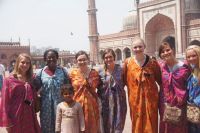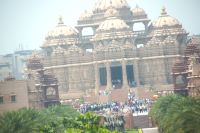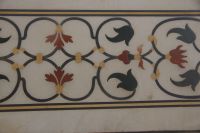On a time machine in Delhi May 4, 2012
If you want to go skiing in the mountains, I’ve always felt, or be at the beach the same day, move to Los Angeles.
India offers not only the chance to travel high (the Himalayas) or in the ocean, but also backward or forward in time. Today, we were somewhere this side of 1500 and the other side of 2012, the same day, at two locations almost within sight of each other.


The pre-1600 was at a village that had been bypassed by the rapid sprawl of Delhi, whose population has increased over 15 X since independence in 1947. Somewhere between 300 and 800 families live in the village we visited; with family size in the rural areas swelled by 5-7 children (there was a prominent case in the paper today about a man who divorced his wife because she would not use birth control devices on their honeymoon!), that meant 1500 to 5600 people live in the village.
Our tour company took us there because the founder, Anup, decided his company had to exercise corporate social responsibility. With financial help from one of his tour groups, Anup’s company adopted the village and tried to make significant contributions in health care. The village had no

doctor, no clinic; initially, Anup fostered diagnostic health care, checkups, etc., but realized that there was no commitment from the village to support the program if his company were unable to continue the work.
By partnering with a nonprofit, the travel company fostered a community group that took responsibility for building and maintaining a hospital, with financial help from the travel agency, the not-for-profit, the government and the town itself. Anup set up the group, which is building a clinic, hiring professional staff (a doctor comes from nearby Gurgaon, the IT satellite village near Delhi 3 hours a day), etc.
That’s the background. A sense of corporate social responsibility led his
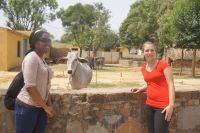
small company to try to make a dent in the village, which has increasingly been drawn into the vortex of suburban New Delhi as the voracious growth of the city has sprawled and overcome the countryside.

We turned off a recently-built four lane expressway onto what in effect was an alleyway, and proceeded about two miles, getting further and further from the 21st century. “We’re not in Kansas anymore,” deadpanned one of the students when a camel sauntered by and everyone rushed over to take pictures. Nor would you see in Kansas the main source of fuel—cow manure, drying on the top of walls, then piled in a picturesque way for further use later.
We went to the “hospital” and spoke with the doctor and nurse, both of whom come from the nearby Gurgaon. The hospital was rejoicing—electricity was about to be joined to the new, four-room building, and so the office person could use a computer to track patients, etc. Bear in mind we were not far from the world class Apollo group, which attracts 20 million people from 55 countries for medical care. I think the doctor told us that a doctor visit was 35 rupees—roughly 75 cents.
Next door was a government sponsored day-care service (some of the villagers I suspect make the commute to Delhi to work) , where children can

learn the two most common languages (of the 18 or so official languages)—Hindi and English—at least those were the charts on the wall. More poignant was the government school, which had a lot of young people (schooling is free till sixth grade), but Anup said the teachers tend to show up only on pay day; one of the consequences of this unofficial elected board that is building the hospital is the activism it has generated, and the villagers have begun to pressure the government to monitor education and actually supply funds for the kindergarten, etc. He was proud of the empowerment he’s seen since his company adopted a small role in a large puzzle: where to start and how to effect lasting change.
One of the most poignant stops on the tour was a “commons” that until recently had been for the common people—the Untouchables. Though Gandhiji, the father of modern India, had sought to batter the caste system that locked people and their descendants into one class—and I think it is technically illegal to discriminate based on caste—old habits die hard. The Untouchables until recently could draw water only from their well. You aren’t old enough to remember it, but when I went to Florida in the early 1950s, we had a similar system in the United States for water fountains and toilets, based on race.
At least in the United States, the dream of rising above caste and class was possible. The iron-clad system may be changing in rural India. School stopped and we became the main source of “education” in the village, as everyone followed us around. One of the local teenagers told one of our students that his ambition was to move to New York and become famous. That’s change!
We went back to “an island of excellence in a sea of chaos,” Gurgaon and the 21st century IT bastion, less than an hour and several centuries away from the village in a much more somber mood. 65% of India is rural, and what we saw might be more typical than we’d like to believe. Someone told me that over 35 million Indians live on 35 rupees a day.
The contrasts at IBM were quite stark. This global multinational, with its $100 billion in revenues, is housed in a modern office building surrounded by other office buildings. We went to a call center, but we were hosted by the director of HR for India (a relative of one of our IWU alums who set up the appointment). It may be because he was the director of HR, but most of what he told us was about the results of the $5 billion that IBM devotes to research, and the need for innovation and invention in the world today. IBM, which used to make machines, now derives 40% of its income from the provision of services, while Lenovo makes the machines that were once synonymous with the company (IBM invented the laptop). One of the projects is a joint venture with the National Geographic Society to genetically map everyone, and to use technology to provide solutions to the problems we saw not too much earlier and not too far away. And some of your customer service calls, in the meantime, might be answered in the call center located in the building we were in.
At dinner, one of my students from the early 1990s joined us. He’s now head

of the Indian operations of a Chicago-based consulting company that among other things managed the New Delhi airport construction in record time, replacing one that was memorable to me for recreating the 1940s!
The last time I visited Sambit was in London in 2001 on a May term trip that took us around the world, but he still remembers IWU and Fred Hoyt fondly. One of his best summers, he told me, was when he worked in Colorado. He said he came from a poor background in West Bengal (one of the poorest states in India) and could not afford the fare to go West. He piggybacked with Troop 19 on our trip to Philmont, and helped sing our troop song at 13,000 feet. I still have the picture, at least in my mind. He also reminded me that he had been hungry and without money one day, and I had loaned him $20. I guess I also practiced corporate social responsibility, and was satisfied that somewhere along the way I had made a difference! The help he gave us here (he was responsible for the factory visit yesterday)—and his success—are certainly payment in full. Today, he’s head of Indian operations, and will take over China in a few months. He and his wife live in a gated community, his two children go to the American school, and he has 20 servants, including two chauffeurs. It is possible…
We are leaving for the Taj Mahal, which, at least for me, defines that Island of Excellence, at least under the Mughal Empire. Sometimes it’s good to go backwards in time! Even at 5 am when we’re leaving our hotel for the fast train to Agra….
 we’ll probably see them somewhere in our trip in China) and coconuts, which we passed on the journey from Bangalore to Mysore. We also passed a number of textile factories, with workers, mostly women, wearing the clothing that they may be making walking to the factories—as typical in India, colorful.
we’ll probably see them somewhere in our trip in China) and coconuts, which we passed on the journey from Bangalore to Mysore. We also passed a number of textile factories, with workers, mostly women, wearing the clothing that they may be making walking to the factories—as typical in India, colorful. Mysore, because I knew (partly from my trip in January) that the area was a hotbed of yoga instruction, and my instructors back home all knew someone who had become a guru by spending time in Ashtanga Ashrams in Mysore. Fortunately, she was able to tie a yoga class with a lunch visit to a farm run by members one of the smaller communities in India. The yoga master appeared on the porch with mats for each of us, and gave about a 45 minute introduction to yoga moves, breathing, and
Mysore, because I knew (partly from my trip in January) that the area was a hotbed of yoga instruction, and my instructors back home all knew someone who had become a guru by spending time in Ashtanga Ashrams in Mysore. Fortunately, she was able to tie a yoga class with a lunch visit to a farm run by members one of the smaller communities in India. The yoga master appeared on the porch with mats for each of us, and gave about a 45 minute introduction to yoga moves, breathing, and  meditation. Who knows, some students may take it up when they return to IWU. The meal was appropriate to the particular community, which numbers 19,000, has its own dialect and clothing, and lives in the mountains farming—including coffee.
meditation. Who knows, some students may take it up when they return to IWU. The meal was appropriate to the particular community, which numbers 19,000, has its own dialect and clothing, and lives in the mountains farming—including coffee. the French and Indian War and the American Revolution). Tipu in particular hated the British so much he composed a diary in Persian in which he dreamed of a victory over the British. When one of his nemeses died in battle, Tipu had a toy built—it was a mechanical tiger that devoured a
the French and Indian War and the American Revolution). Tipu in particular hated the British so much he composed a diary in Persian in which he dreamed of a victory over the British. When one of his nemeses died in battle, Tipu had a toy built—it was a mechanical tiger that devoured a  British soldier. When Tipu died in 1799, betrayed when one of his officials, bribed by the British, opened a passageway and let British troops in, the British supposedly drank on the corpse, toasting, “Death to India.” The tiger-toy now reposes in the Victoria and Albert Museum, while millions of Indians toast Tipu. Ironically, he was defeated by troops led by Lord Cornwallis, fresh from his role at Yorktown.
British soldier. When Tipu died in 1799, betrayed when one of his officials, bribed by the British, opened a passageway and let British troops in, the British supposedly drank on the corpse, toasting, “Death to India.” The tiger-toy now reposes in the Victoria and Albert Museum, while millions of Indians toast Tipu. Ironically, he was defeated by troops led by Lord Cornwallis, fresh from his role at Yorktown. other was in Bangalore. Both were fine examples of Islamic art, with the arches, open air sections, with some explanations about Tipu and his wars with the British.
other was in Bangalore. Both were fine examples of Islamic art, with the arches, open air sections, with some explanations about Tipu and his wars with the British. palace, but as I said, have opened up large areas to the public, including what used to be the public assembly hall, which in size and decoration rivals palaces in Europe. It is said that the Maharajah burned down its predecessor in 1897 because he wanted the opportunity to rebuild. It has lots of carved teak features, inlaid gold and silver doors, chandeliers imported
palace, but as I said, have opened up large areas to the public, including what used to be the public assembly hall, which in size and decoration rivals palaces in Europe. It is said that the Maharajah burned down its predecessor in 1897 because he wanted the opportunity to rebuild. It has lots of carved teak features, inlaid gold and silver doors, chandeliers imported from Europe, and a display of possessions that includes an 80 kg gold howda for riding the royal elephant and a 200 kg gold throne.
from Europe, and a display of possessions that includes an 80 kg gold howda for riding the royal elephant and a 200 kg gold throne.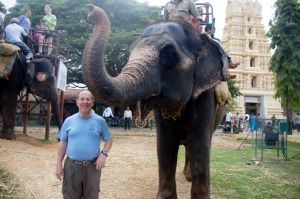 mile ride from Mysore to Bangalore. One of the reasons it took 4+ hours was the construction in Bangalore of a metro system. The other was the fact that the highway goes through every town, and to make people slow down, has speed bumps and a series of barriers that you have to dodge around.
mile ride from Mysore to Bangalore. One of the reasons it took 4+ hours was the construction in Bangalore of a metro system. The other was the fact that the highway goes through every town, and to make people slow down, has speed bumps and a series of barriers that you have to dodge around.





